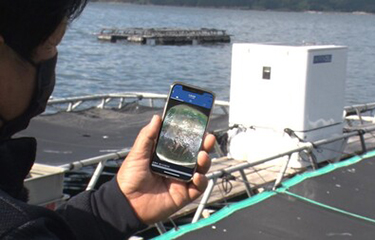From 2 to 15 December, 2022, Kura Sushi featured farmed “AI Sumagatsuo” at it restaurants in Japan for the first time.
The “AI Sumagatsuo” – also known as eastern little tuna or mackerel tuna in English – is the third fish species being farmed at the sushi chain’s Kura Osakana Farm, joining its farming of red sea bream and yellowtail. Kura Sushi said its first batch of farmed mackerel tuna totaled 6 metric tons, and the company intends to double production in 2023.
The fish are farmed through a process utilizing artificial intelligence provided by Umitron Corporation, a Tokyo, Japan-based technology firm that has moved into the aquaculture space.
“The aim is to reduce procurement costs and stabilize purchases by using domestically farmed fish," Kura Sushi said in a press release.
About 70 percent of Kura Sushi’s sushi toppings are imported, and procurement costs are increasing due to rising prices and the weak yen. Additionally, Japanese aquaculture is suffering labor shortages and increased production costs – including the cost of feed. The use of automation, and of AI to regulate the feeding amount, helps to address these issues, Kura Sushi said.
Mackerel tuna is relatively rare in Japanese markets. In the wild, the fish primarily live in small groups in shallow water, making it hard for commercial fishermen to target. However, it has some advantages when grown via aquaculture It reaches sexual maturity and reproduces in as little as 12 months in temperature-controlled tanks, and grows faster and has smaller space requirements than bluefin tuna, which is also being farmed in larger volumes in Japan.
Kura Sushi collaborated with Ehime Prefecture, Ehime University, and aquaculture companies in Ehime Prefecture to produce the “AI Sumagatsuo.” It took about six months from hatching to grow the fish to a shipping size of 1.2 to 1.3 kilograms.
Ehime University’s South Ehime Fisheries Research Center has been developing high-performing mackerel tuna strains by selecting fast-gaining individuals and implanting their germ cells to sterilized early-maturing host fish to produce germline chimeras. The chimera has the reproductive cells of the superior donor fish.
The university introduced its “Himesuma” branded product at the Seafood Show Osaka 2020. At that time, Ehime University Professor Satoshi Kanao described the meat as resembling chu-toro (medium fatty bluefin tuna).
Separate development efforts to grow mackerel tuna are also underway at the Wakayama Prefectural Fisheries Experiment Station in cooperation with Tokyo Marine University.
Kura Sushi established its fully-owned subsidiary called Kura Osakana Farm Co. in November 2021, in order to become more vertically integrated. The subsidiary does not farm fish directly, as local fishery cooperatives have first priority access to aquaculture sites in Japan. Instead, it consigns production to existing producers.
In addition to making medium-term and long-term purchasing contracts, Kura Osakana Farm Co. supplies the operators with fry. The company purchased Umitron CELL smart-feeders from Umitron, which it leases to operators in Uwajima, Ehime Prefecture, where the mackerel tuna was farmed.
The Umitron CELL machine, developed by Umitron, incorporates artificial intelligence and other cutting-edge technologies into aquaculture processes. It has a large hopper holding several days’ worth of feed, making it possible to remotely feed fish while watching real-time video of the fish swimming in the cage from a smartphone. An AI-enhanced technology developed by the company uses the swimming behavior of the fish to determine their appetite. It then optimizes the amount of feed by accurately calculating the fish size and the feed requirements, and controls the speed of feeding. This prevents wasted feed, which both saves money and reduces the environmental load on the surrounding sea.
Umitron promotes its feeders not just as a labor- and money-saving devices, but also as contributing to achieving the United Nations' Sustainable Development Goals.
“Umitron CELL makes a contribution to both improved efficiency and environmental effect. For example, for Kura Sushi AI yellowtail (hamachi), we can reduce the feed amount by 10 percent from the usual produce using the Umitron CELL,” Akiko Sato, who runs public relations at Umitron, told SeafoodSource. “Also, Kura Sushi told us that farmers now only need to go to the fish pen once every two to three days by using remote feeding control. It leads to reducing the number of boat trips to the fish cage and improving farmers' work conditions.”
For yellowtail, most fish farms in Japan use pelletized feeds when the fish are young, but switch to moist pellets made with frozen fish when the yellowtail are closer to harvesting. However, Sato said, Kura’s yellowtail is different.
“Kura Sushi yellowtail is produced entirely on pellet-type feed. Therefore, our product, Umitron Cell, can be used throughout the entire growing season, reducing the number of boat trips to the fish cage,” Sato said.
In a large-scale feed optimization demonstration using Umitron CELL and the company’s fish appetite index (FAI), red sea bream producers were able to successfully use the smartphone-based technology to achieve a 20 percent reduction in feed amounts while maintaining fish quality. Their fish also reached target harvesting size in 10 months, rather than one year.
Several dozen fish farmers, mainly in the Shikoku, Kyushu, and Kinki (Hyogo, Nara, Shiga, Wakayama, Mie, Kyoto, and Osaka prefectures) regions, have installed Umitron Cell units. Umitron units have also caught on in Peru as the company has begun to market the technology internationally.
Photo courtesy of Umitron







